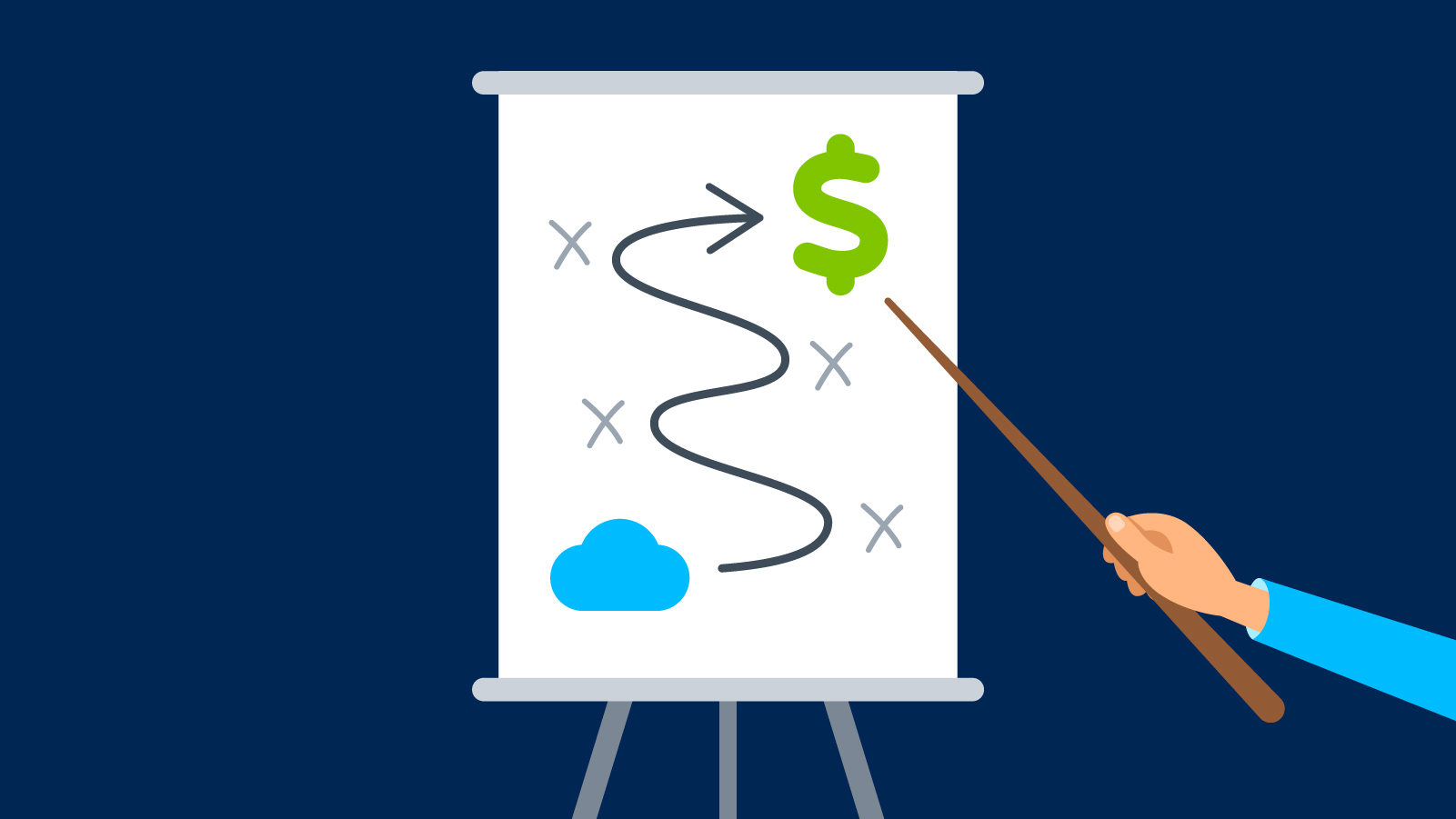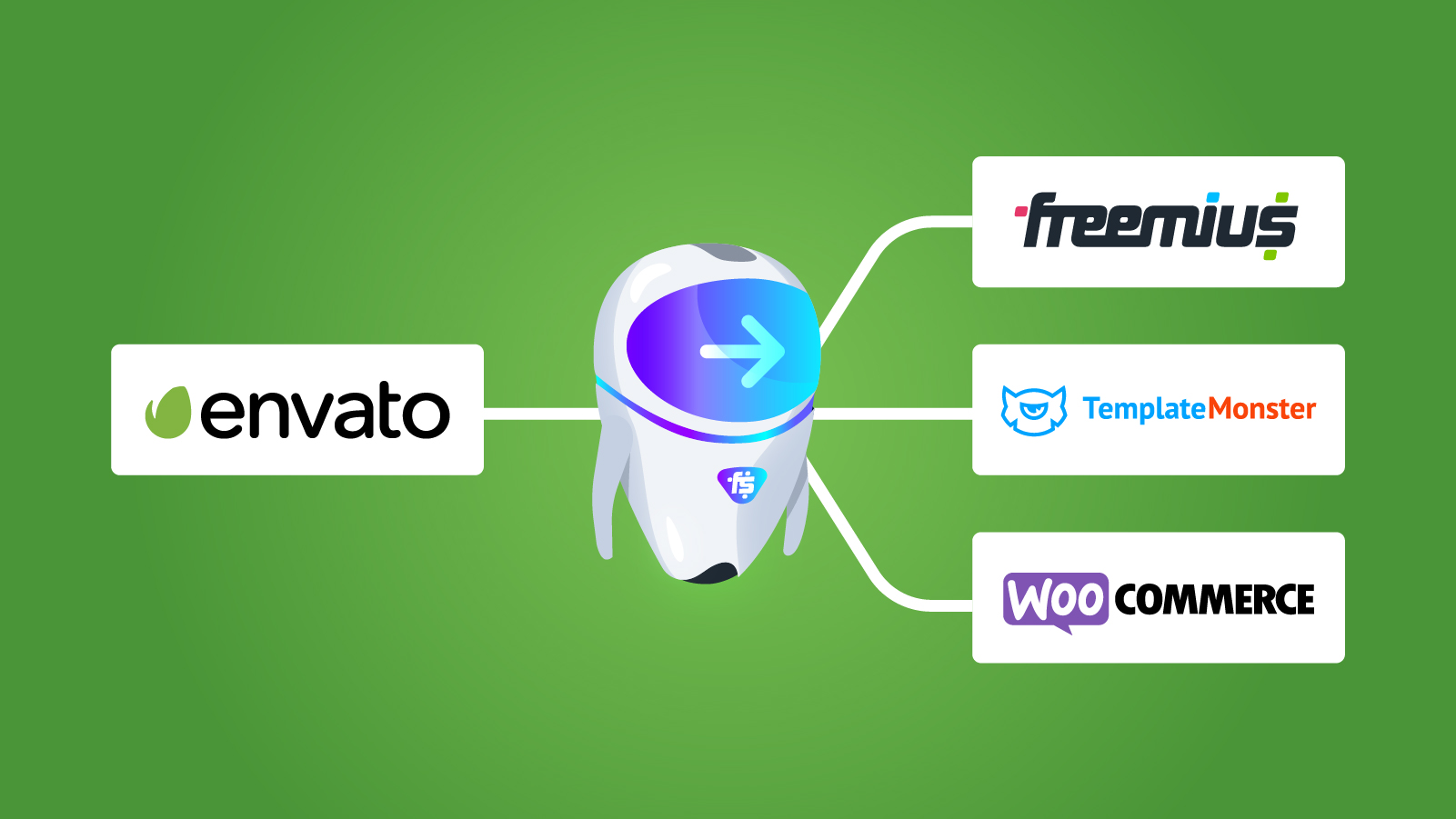|
|
As a WordPress theme or plugin developer, you’ve likely felt the tremors caused by Shutterstock’s acquisition of Envato.
This significant shift in the industry landscape has left many questioning the wisdom of relying on a single marketplace for their livelihoods. What happens when the platform you’ve built your business on suddenly changes course?
This isn’t an easy question to answer, so we invited leading professionals from the WordPress space to share their perspectives in our latest webinar:
- James Giroux, former Envato Author Engagement Lead
- Xaver Birsak, Power Elite Author from Mailster
- Konstantin Pronkevych, CMO of ThemeRex
- Vova Feldman, Freemius founder and CEO
You can watch the full webinar below or read this article where we extract the pros and cons of going non-exclusive, with unique insights from our panelists to help you navigate this crucial transition and secure your place in the evolving WordPress ecosystem.
Understanding the Current Marketplace Landscape
Before we dive into the pros and cons of diversifying your sales strategy, let’s provide a little bit of context.
Shutterstock’s acquisition of Envato for $245 million appears to be primarily focused on Envato Elements, the subscription-based platform for digital assets. In their press release and investor documents, Shutterstock emphasized Envato Elements and its 650,000 subscribers, while not mentioning ThemeForest or CodeCanyon at all, which heavily suggests that Shutterstock’s main interest lies in the digital asset subscription model rather than individual WordPress themes and plugins.
So, what does this mean for the future of ThemeForest and CodeCanyon?
It seems uncertain under Shutterstock’s ownership. Given Shutterstock’s core business in stock photography and lack of experience with software products, there are concerns that these marketplaces may receive less attention and investment. Some experts speculate that Shutterstock might eventually sell off or close these platforms if they don’t align with their long-term strategy.

In light of these developments, WordPress theme and plugin developers are now facing several challenges, such as:
- Declining sales and traffic on Envato marketplaces: Many authors have reported a downward trend in sales and traffic on Envato marketplaces in recent years. For example, Xaver Birsak mentions in the webinar that he noticed a steady decline in unique page views for his product since 2022. This downward trend has led some authors to explore alternative selling platforms or go independent.
- The rise of page builders and their impact on theme businesses: The increasing popularity of page builders has disrupted the traditional theme market. These tools allow users to create custom designs without relying on pre-built themes, potentially reducing demand for niche, single-purpose themes that were once popular on ThemeForest. This shift has forced many theme developers to adapt their business models or explore new opportunities within the WordPress ecosystem.
Many WordPress product makers are actively exploring alternatives to Envato marketplaces and considering options like selling directly through their own websites, using alternative platforms (like Freemius), or diversifying their product offerings to remain competitive in the evolving WordPress landscape.
If you’re considering some of these options as an alternative to Envato, take a closer look at the pros and cons of going non-exclusive as well as the strategies you can implement to ensure a smooth transition to new sales channels.
Pros of Going Non-Exclusive
The shift to a non-exclusive selling model allows you to sell your product(s) on multiple platforms, including your own website, rather than being tied to one marketplace. Why take this approach?
Let us walk you through the benefits of going non-exclusive for WordPress product creators:
Increased Control Over Pricing and Marketing
Moving away from exclusive marketplace arrangements gives you much greater flexibility in how you position yourself and sell your products. This increased autonomy can open up new opportunities for growing your WordPress business:
Flexibility in Pricing Strategies
Non-exclusive software makers can experiment with different pricing models to maximize revenue and attract customers. For example:
- Implementing subscription-based pricing for ongoing access and updates
- Offering tiered pricing plans with different feature sets
- Running seasonal promotions or limited-time discounts
- Bundling multiple products together at a package rate
Xaver confirms in the webinar that, when selling through a marketplace, you need to comply with whatever terms the platform introduces, so going non-exclusive was an easy decision for him. “With this change, I can have multiple plans. I have a subscription model now. And in the end, it was a no-brainer,” says Xaver.
Building Direct Relationships with Customers
Direct sales let WordPress developers collect valuable customer data and nurture long-term relationships through:
- Gathering feedback: Direct interaction enables you to collect valuable feedback and feature requests, leading to better product iterations.
- Improved customer support: You can communicate directly with users, providing faster and more personalized support.
- Targeted upselling and cross-selling: With access to customer data, you can promote related products or offer targeted upgrades to existing customers.
- Brand building: You can create a strong brand identity and build customer loyalty outside the constraints of a marketplace’s branding.
Thanks to these expanded capabilities, you’re less hindered by marketplace limitations and can run your business your way.
And today, with all the automation and AI tools, direct sales aren’t as difficult and time-consuming. As Vova Feldman, Freemius founder and CEO, observes: “What’s left are the technicalities of selling and licensing and related, and this is already a “solved problem” these days.”
Check out our WordPress Developer’s Marketing Handbook for proven strategies and tips for WordPress product makers.
Diversification of Revenue Streams
The Envato acquisition taught us all that relying solely on marketplaces like ThemeForest or CodeCanyon can be risky.
That’s why forward-thinking theme and plugin creators should be looking to diversify their revenue streams. Different monetization models and selling through various channels help you create a more stable and potentially lucrative business.

So, what are some key strategies you can implement to achieve this goal?
Exploring Subscription Models
Subscription-based pricing is becoming increasingly important, as highlighted by Shutterstock’s focus on Envato Elements. For individual developers, it can provide a steady, predictable income while offering ongoing value to users.
Here’s how you can make it work:
- Tiered subscriptions: Offer different levels of access or features at various price points. This approach allows you to cater to different customer needs and budgets.
- Freemium model: Provide a free version of your theme or plugin with core features, then offer a premium subscription for advanced functionality. As Xaver mentions in the webinar, this can help you build an audience and increase conversions over time.
- Maintenance plans: Bundle your product with ongoing support, updates, and additional services to create long-term value for customers.
In the sea of subscription-model businesses offering similar functionality, it may be challenging to stand out now that you’re on your own, though. Here’s a tip from Vova: focus on mass-market solutions that every website needs, but bring your own unique angle.
Even capturing a small percentage of a large market can be very profitable.
Selling Through Multiple Channels
Relying on ThemeForest or CodeCanyon only? It’s like putting all your eggs in the same basket… and then letting someone else hold the basket. By diversifying your sales channels, you can reduce your dependence on any single platform.
Here are some ways to direct your sales efforts better:
- Your own website: As emphasized by multiple panelists in our webinar, setting up your own e-commerce site is crucial. It gives you full control over the user experience, allows you to keep a larger portion of the revenue, and helps you build a direct relationship with your customers.
- Non-exclusive selling: As Xaver illustrates with his own example, going non-exclusive on marketplaces while selling through your own channels can significantly boost your income. Consider raising prices on marketplaces to compensate for commission differences.
- Building your audience through email marketing: Owning an email list lets you communicate any updates, new products, and special offers directly to your customers. Collect customer data, build an email list, and focus on driving traffic to your own website, even if you continue selling on marketplaces.
Speaking of email lists, James Giroux, former Author Engagement Lead at Envato, emphasizes the value of actively engaging with your buyers.
He says “the most important thing you can do as an author is to own your own audience,” and advises:
Do everything you can to make sure that the people who are buying your products are people you know.
Remember, diversifying your revenue streams is not just about maximizing profits — it’s about creating a resilient business that can weather market changes.
Konstantin Pronkevych, CMO of ThemeREX, recommends that you should have multiple plans and keep working to improve your products and marketing efforts. By exploring subscription models, expanding your sales channels, and focusing on building your own audience, you’ll be better equipped to thrive in the evolving WordPress ecosystem and build a sustainable business.
Vova confirms: “I think it’s a [combination] of driving traffic and the benefit of going non-exclusive and starting to build [your] subscription base. So in case something bad happens, you have that extra cushion.”
Cons of Going Non-Exclusive
The transition from exclusive to non-exclusive selling on marketplaces like Envato’s ThemeForest and CodeCanyon isn’t without its challenges.
Xaver points out in the webinar: “The marketplace still brings about 25% of my traffic to my site. But it’s not 25% of my income anymore.” This highlights a key consideration: while going non-exclusive may boost your income, you might lose some of the visibility and traffic that comes with being on a major marketplace.
Let’s get into the details…
Potential Loss of Marketplace Visibility and Traffic
Envato marketplaces, particularly ThemeForest and CodeCanyon, have a large, established user base. As James pointed out, “Envato still powers 43% of the CMS web.” An abrupt departure means losing immediate access to this substantial traffic source.
So, moving away from this exclusivity could lead to reduced sales and visibility, impacting overall revenue:
- On ThemeForest and CodeCanyon, you’ve got a bunch of potential customers just browsing around. They might stumble upon your stuff without even looking for it. When you’re not exclusive, you might show up less in these casual browsing sessions.
- Envato’s search algorithms tend to favor exclusive items. So when you go non-exclusive, your products might drop down in the search results. You’re still there, but you’re not as easy to find.
- Envato’s setup makes it super easy for people to buy on a whim. When you’re selling elsewhere, you might miss out on those spur-of-the-moment purchases.
- Some buyers really trust Envato’s vetting process. When you’re on your own, you’ve got to build that trust from scratch.
- Envato has a whole ecosystem where buyers often purchase multiple items in one go. You might lose out on those “while I’m here” sales.
- Envato does some marketing for you. Going non-exclusive means you’re now competing with their marketing efforts instead of benefiting from them.
Konstantin highlights that many authors thrive on the traffic driven by the platform’s large audience and find it challenging to replicate it on other platforms or their own websites.
Some investment in marketing will likely be necessary, because without the marketing machinery of Envato, authors must develop and execute their own marketing strategies, which can be time-consuming and requires a whole new skill set.
The upside? This shakeup could be your push to start really building your platform. It might be tough at first, but in the long run, you’re not at the mercy of someone else’s business decisions.
Remember, plenty of developers have successfully made the switch and grown their businesses independently — like Unlimited Elements, who left CodeCanyon and switched to the Freemius platform, after which their sales skyrocketed. It’s just about being prepared for the change and ready to put in some extra work to keep your products visible and attractive to buyers.

Increased Responsibilities in Customer Support
Going non-exclusive means taking on the full burden of customer support, which would have been managed by the platform.
This can be a daunting task as handling queries, troubleshooting issues, and ensuring customer satisfaction can be overwhelming, and many authors are more focused on creation than on business operations.
Until now, Envato’s been handling a lot of the customer support load for you. When you go non-exclusive, suddenly, you’re looking at:
- Your emails blowing up
- Customers expecting you to be online and available 24/7
- Having to write clear, detailed docs on using your product
- Struggling to build a proper ticketing system
- Dealing with refund requests
- Feature request frenzy
- Endless questions about compatibility with different themes, plugins, and WordPress versions
- Getting questions about basic tech concepts from non-tech-savvy users
- Needing to keep an eye on social media and customers reaching out through X, Facebook, etc.
That’s a lot, right? But here’s the thing – it’s also an awesome opportunity to really connect with your users, get direct feedback, and build a solid reputation for great support. Plus, you’ll probably learn a ton about your product and your customers in the process.
Patience is key here, as success in this new landscape requires adaptability and proactivity. James shares a nugget of wisdom:
Instead of being controlled by fear, try to take control of your own destiny than react to what’s happening. Come up with a proactive plan to move forward.
This sentiment is echoed by Konstantin, who stresses the importance of having multiple plans and continuing to work hard regardless of the path you choose: “You probably have to have more than one plan, […] two or three even, and also keep all the doors open and working.”
Best Strategies for Transitioning to Non-Exclusive
Making an abrupt switch away from Envato can be potentially risky.
Many developers rely on consistent income from Envato sales. A sudden switch could lead to a significant drop in revenue before alternative channels are fully established.
Envato also owns the customer data for purchases made through their platform. As James mentions, “When somebody buys your product through Envato, all of that customer data goes to Envato. It doesn’t go to you.” Abruptly leaving means potentially losing contact with your existing customer base.
Selling independently also requires setting up payment systems, licensing, and support infrastructure. These systems need time to implement and refine.
By creating these processes gradually, you can mitigate the risks we mentioned and build your independent presence while still benefiting from Envato’s established ecosystem. This means you’ll maintain your presence on ThemeForest or CodeCanyon while building alternative sales channels.
This approach provides a safety net as you explore new options.
Key steps for a gradual transition include:
- Going non-exclusive on Envato marketplaces
- Setting up your own website and starting to drive traffic to it
- Implementing email collection strategies to build your audience
- Gradually shifting focus to your independent sales channels
During the first few months, you could maintain full operations on Envato, but direct 25% of your development and marketing efforts to your site. Then, increase to 50% focus on your site and start offering “early access” or exclusive features to direct customers as an incentive.
After around nine months, shift to 75% focus on your site. You can even consider launching a new product exclusively on your platform. After this phase, it’s time to evaluate your progress and plan the next steps based on the results — is your website generating comparable or higher revenue than Envato?
Pricing Strategies for the Transition
When going non-exclusive, you’ll face a reduced commission rate on Envato marketplaces. However, this doesn’t have to mean reduced profits. Our panelists talked about some of the possible solutions:
Increasing Your Price on Envato
To maintain your profit margins, you may need to increase your prices. Here’s how to approach this:
- Calculate your new break-even point: Determine the price increase needed to maintain your current profit per sale.
- Gradual increase: Consider raising prices incrementally (for example, 10% every month) to avoid shocking your customers.
- Value-based pricing: Justify the increase by adding new features or enhancing your product.
As Xaver shares, a “pumped-up price on the marketplace” may ensure that you still get your share of revenue.
Offering Competitive Pricing on Your Website
Use the price difference to incentivize direct purchases. The goal here is to make your website more attractive to buyers:
- Slight discount: Offer your products at a small discount (5-10%) compared to Envato.
- Bundle deals: Create exclusive bundles or packages only available on your site.
- Introductory offers: Give new customers a special discount for their first purchase.
Implementing a Subscriptions Model
Subscriptions can provide more stable, predictable revenue. Here’s how to approach this:
- Annual plans: Offer a discount for yearly subscriptions to encourage long-term commitments.
- Tiered pricing: Create different levels of access or support to cater to various customer needs.
- Freemium model: Offer a basic version for free, then charge for premium features.
Remember, pricing is not just about maintaining profits — it’s also a powerful tool for steering customer behavior. Your goal should be to gradually shift your customer base from Envato to your own platform while maintaining a steady income.
Subscribe and grab a free copy of our WordPress Plugin Business Book
Exactly how to create a prosperous WordPress plugin business in the subscription economy.

Tools and Platforms for Independent Selling
Transitioning to independent selling doesn’t mean you have to build everything from scratch. If you partner with a merchant of record, things may run more smoothly.
If this term’s new to you, a merchant of record (MoR) is a legal entity that sells goods or services to an end customer, taking on the financial and legal responsibility for the transaction. For independent developers, becoming your own MoR can be complex and risky because of all the additional work required regarding compliance, payments, and more (which you may not be experienced in).
This is where platforms like Freemius come in. Freemius handles licensing, processes payments and taxes, and provides valuable insights to WordPress developers going non-exclusive.
Here are some benefits to consider:
- Simplified payments and taxes
- Freemius handles payment processing across multiple payment gateways
- We manage tax calculations and remittance globally, including VAT for European customers and US sales tax
- This saves you from navigating complex international tax laws and regulations
- Licensing and software delivery
- Freemius provides a robust licensing system for your plugins or themes
- We handle secure software delivery and automatic updates
- This ensures your customers always have the latest version and helps prevent piracy
- Subscriptions and recurring payments
- Easily set up subscription-based pricing models
- Freemius manages recurring billing, including failed payments and dunning
- This can significantly increase your average customer lifetime value
- Analytics and insights
- Gain access to detailed analytics about your sales, conversions, and customer behavior
- Use these insights to make data-driven decisions about pricing, features, and marketing
- Affiliate management
- Freemius includes built-in affiliate management tools
- This allows you to easily set up and manage an affiliate program to boost your sales
- Compliance and security
- Freemius ensures compliance with data protection regulations like GDPR
- The platform handles sensitive customer data securely, reducing your liability
- Flexibility and control
- Unlike Envato, Freemius allows you to own your customer data and relationships
- You have more control over pricing, promotions, and product presentation

By using a platform like Freemius, you can focus on what you do best — developing great WordPress products — while we handle the complex back-end operations. This makes the transition to independent selling much smoother and less risky.
As Vova, the founder of Freemius, points out: “If you go with Freemius, you get this whole commercial aspect solved for you out of the box.” This allows you to compete effectively with larger players in the WordPress ecosystem, even as an independent developer.
Future-Proofing Your WordPress Business
The Envato acquisition is just the latest reminder that you should spread your risk. So, what can you do to stay ahead of the game?
First up, let’s talk about mixing things up with your products. Think about it — if you’ve been selling general themes, why not try something more niche? Maybe themes for restaurants or fitness studios? Or if you’ve got a popular plugin, consider creating some cool add-ons for it. Also, have you thought about offering services? Some folks might pay good money for your expertise in customization or support.
Now, about your brand. You want people to follow you, not just a marketplace, right? Share what you know — write blog posts, do webinars, speak at WordPress events. Get out there and show off your skills! And don’t forget about your users. Create a space for them to connect, maybe a forum or regular Q&A sessions. Happy customers are like your personal cheerleaders; they’ll spread the word about you.
So, what’s next? First, take a good look at where you’re at. How much are you relying on Envato or other marketplaces? Is there room to branch out with your products?
Then, start planning your move. If you’re exclusive with Envato, think about when you want to change that. Look into platforms like Freemius for selling on your own. And don’t forget to think about your pricing – it might need to be different on your site versus Envato.
Remember what James said about not letting fear call the shots? That’s solid advice. Be proactive, come up with a plan (or even better, a couple of plans), and keep moving forward. As Konstantin points out, it’s good to keep your options open.
The Road Ahead — What’s Your Next Step?
While the future of Envato marketplaces may be uncertain, the opportunities for independent WordPress developers and theme creators are promising. By taking control of your sales channels, building direct relationships with customers, and diversifying your revenue streams, you can create a more sustainable and profitable business in the long run.
The transition may require effort and adaptation, but with the right strategies and tools, you can turn this period of change into an opportunity for growth and independence in your WordPress business.
If you’re already considering alternatives to Envato, check out this blog post where we review the top five alternative marketplaces for WordPress product makers.








